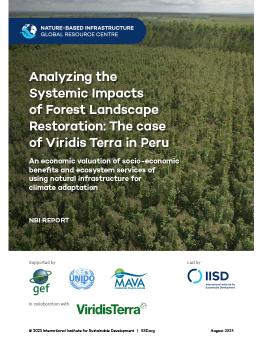
Analyzing the Systemic Impacts of Forest Landscape Restoration: The case of Viridis Terra in Peru
An economic valuation of socio-economic benefits and ecosystem services of using natural infrastructure for climate adaptation
This assessment demonstrates that land restoration in the Peruvian Andes will provide multiple benefits, such as job creation and improved climate adaptation, including reducing the risk of landslides, improving water availability, and increasing carbon storage.
Rural communities in the Peruvian Andes are heavily impacted by climate change and land degradation. They rely on agriculture and livestock for their livelihoods, and their productivity is often affected by erratic rainfall patterns, prolonged droughts, and soil erosion. As a result of these challenges, rural communities face a range of socio-economic issues, including food insecurity, poverty, and migration to urban areas.
Land restoration can help address the root causes of land degradation and promote the development of sustainable land management practices. By restoring degraded ecosystems and promoting the regeneration of forests, these initiatives can help improve soil health, increase water retention, and support the recovery of local biodiversity. These measures can also help to tackle climate change by reducing the risk of landslides, improving water availability, and increasing carbon sequestration.
Moreover, land restoration initiatives can provide a range of economic opportunities for rural communities, including the production of non-timber forest products and increased agricultural production through agroforestry. By involving women in these initiatives, land restoration can also help to promote gender equality and women’s empowerment in rural communities.
We conducted a Sustainable Asset Valuation (SAVi) assessment of nature-based infrastructure (NBI) in the Peruvian Andes. This is intended to provide an estimate of the system-wide economic impacts of landscape restoration practices and the value this can generate for the community and landscape (i.e., investment vs. benefits). SAVi aims to go beyond a conventional cost-benefit analysis (CBA) by providing a more comprehensive analysis of the systemic impacts of infrastructure investments throughout their life cycles.
The benefits of land restoration include a number of environmental, economic and social impacts, with the greatest seen in livelihood protection for the community, including job creation and greater agricultural resilience in the face of climate change.
Participating experts
You might also be interested in
How Can We Work With Nature to Tackle Drought and Desertification?
Drought is one of the most devastating and pervasive challenges exacerbated by climate change. However, we can work to reduce its effects through nature-based solutions for land restoration and climate-smart agriculture.
IISD Annual Report 2022–2023
At IISD, we’ve been working for more than three decades to create a world where people and the planet thrive. As the climate crisis unfolds on our doorsteps and irreversible tipping points loom, our team has been focused more than ever on impact.
Sustainable Asset Valuation of Ecosystem-Based Adaptation Measures in the Reventazón River Basin, Costa Rica
In this integrated cost-benefit analysis, the Nature-Based Infrastructure (NBI) Global Resource Centre demonstrates the potential of ecosystem-based adaptation to stabilize hydrology and ensure a reliable water and energy supply in the Reventazón region of Costa Rica.
Sustainable Asset Valuation of Reforestation in Uganda
In this integrated cost-benefit analysis, the Nature-Based Infrastructure Global Resource Centre demonstrates the potential of nature-based infrastructure (NBI) to improve climate-related flooding and landslides in Kasese, Uganda, through the Bring Back Our Trees reforestation project.